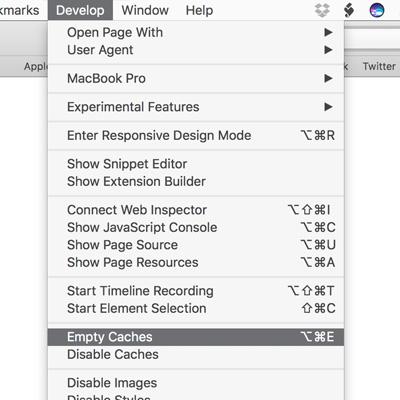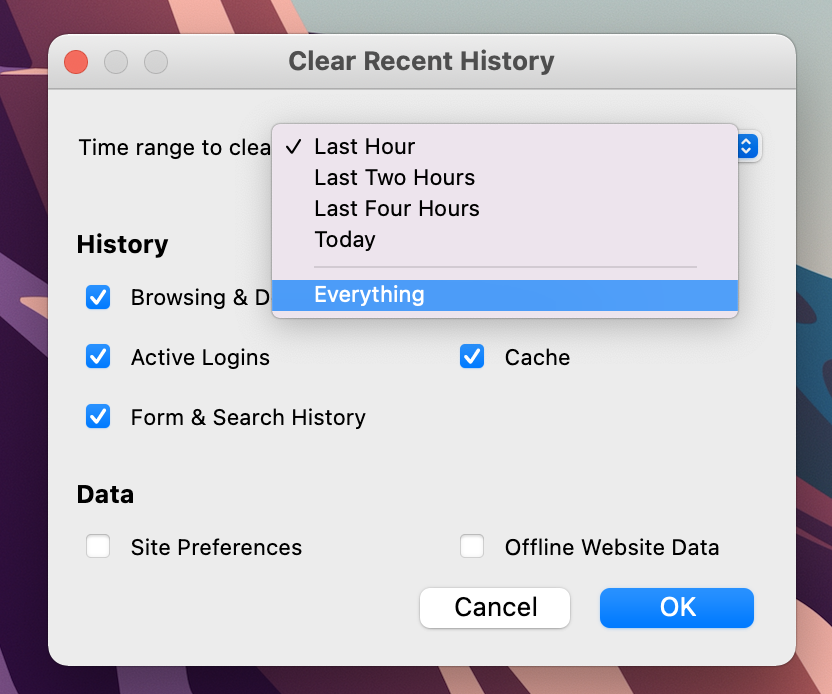

- #CLEAR BROWSER CACHE FIREFOX MAC OS X HOW TO#
- #CLEAR BROWSER CACHE FIREFOX MAC OS X MAC OS X#
- #CLEAR BROWSER CACHE FIREFOX MAC OS X PASSWORD#
- #CLEAR BROWSER CACHE FIREFOX MAC OS X WINDOWS#
However, this doesn’t affect the recommendations our writers make. We may earn commissions on purchases made using our links. IGeeksBlog has affiliate and sponsored partnerships. If you have any questions related to this, please toss it up in the comments below.
#CLEAR BROWSER CACHE FIREFOX MAC OS X HOW TO#
How to Change DNS on Your iPhone or iPad Easily. For this enter chrome://net-internals/#dns in Chrome’s address bar. Additionally, if you like, you can also choose to clear DNS Cache only for the Google Chrome browser. Hopefully, getting rid of the DNS cache will no longer be a big deal for you. To clear DNS cache on macOS Lion, Mountain Lion, and Mavericks, enter the following syntax: To clear DNS cache on macOS Yosemite, enter the following syntax: If you are using an older version of macOS, then here are the commands for those. You have successfully cleared the DNS Cache on your Mac! Most likely, now you will have no trouble visiting websites or seeing webpages. Once it’s done, a verbal audio alert will confirm that the DNS cache is flushed on your Mac. #CLEAR BROWSER CACHE FIREFOX MAC OS X PASSWORD#
Enter your Mac’s password and then press the enter key again.ĭone! Now, you may have to wait for a few moments until the DNS cache is completely flushed out. Now, you need to enter the command given below. Open Terminal using Launchpad or Use Finder → Applications → Utilities, or Spotlight Search (Command+Space Bar) for this. How to Flush DNS Cache on Macįor macOS Catalina, Mojave, High Sierra, Sierra, and macOS El Capitan the command is the same. Finally, regularly flushing DNS cache may also help in hiding search behavior and offer security against manipulation. It does so by clearing the outdated entries and fetching the new ones. It also lets you correctly see the new version of a website, in case the site has recently moved its servers. If you are having trouble accessing a website on your Mac, or if webpages do not load properly, clearing DNS cache will help. I found the way to do it in Firefox, but I cant find the way for Google Chrome. As Im begining to know this technology, I need to be able to delete an indexedDB by hand so I can start over. Clear DNS Cache in Older macOS versions Im working in a project which involves using IndexedDB. Let’s check out the way to clear the DNS cache on your Mac. Besides, it also gets rid of invalid records. The action will remove all the DNS entries. To troubleshot cache poisoning or other internet connectivity issues, you may need to flush the DNS cache. It consists of the records of recent as well as attempted visits of websites along with domains. sudo /etc/init.A DNS cache or DNS resolver cache, is a temporary database of DNS lookups on the OS and browser. You may need to enter your password to finish the process. If you use BIND for DNS service, there are a few commands you can use to flush its DNS cache. You will see the response when the service stops and starts again. 
Use this command to clear the dnsmasq DNS cache on your Linux machine: sudo /etc/init.d/dnsmasq restartĮnter your password again, if the terminal asks you to. The process stops and then starts the NCSD service within seconds. Use this command to clear NCSD DNS cache on your Linux machine: sudo /etc/init.d/nscd restartĮnter your password if necessary. Press Ctrl+Alt+T on your keyboard and use the corresponding command to clear the DNS cache for the service your Linux system is running. Some of them are NCSD (Name Service Caching Daemon), dnsmasq, and BIND (Berkely Internet Name Domain).įor every distribution, you need to launch a terminal window. It depends on which service you have on your distribution and whether it is enabled by default. Some distributions, like Ubuntu, don’t have a default DNS service at all. Each Linux distribution might use a different DNS service.
#CLEAR BROWSER CACHE FIREFOX MAC OS X WINDOWS#
Linux distributions are a bit different from Windows and Mac machines. You should get the correct and updated IP mapping from DNS servers next time your machine sends a DNS query. The DNS Cache database on your computer is now clear. Open the Start Menu and start typing command prompt until you see it in the results. Load the Command Prompt as an administrator. Foe the example below, we will be using Windows 10.ġ. The procedure is the same for almost all Windows systems. Sudo discoveryutil mdnsflushcache sudo discoveryutil udnsflushcachesĬlearing DNS cache is an easy and quick process.

Sudo dscacheutil -flushcache sudo killall -HUP mDNSResponder You can copy and paste them directly from the table into your terminal.
#CLEAR BROWSER CACHE FIREFOX MAC OS X MAC OS X#
The table below lists the commands for clearing the DNS cache on most macOS and Mac OS X versions. For example: sudo killall -HUP mDNSResponder say dns cleared successfully Flush DNS Commands on Older macOS and Mac OS X Versions Note: If you want to hear an audio notification after the DNS flush is complete, type say some text after the first command.







 0 kommentar(er)
0 kommentar(er)
